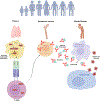Human autoantibodies neutralizing type I IFNs: From 1981 to 2023
- PMID: 38193358
- PMCID: PMC10950543
- DOI: 10.1111/imr.13304
Human autoantibodies neutralizing type I IFNs: From 1981 to 2023
Abstract
Human autoantibodies (auto-Abs) neutralizing type I IFNs were first discovered in a woman with disseminated shingles and were described by Ion Gresser from 1981 to 1984. They have since been found in patients with diverse conditions and are even used as a diagnostic criterion in patients with autoimmune polyendocrinopathy syndrome type 1 (APS-1). However, their apparent lack of association with viral diseases, including shingles, led to wide acceptance of the conclusion that they had no pathological consequences. This perception began to change in 2020, when they were found to underlie about 15% of cases of critical COVID-19 pneumonia. They have since been shown to underlie other severe viral diseases, including 5%, 20%, and 40% of cases of critical influenza pneumonia, critical MERS pneumonia, and West Nile virus encephalitis, respectively. They also seem to be associated with shingles in various settings. These auto-Abs are present in all age groups of the general population, but their frequency increases with age to reach at least 5% in the elderly. We estimate that at least 100 million people worldwide carry auto-Abs neutralizing type I IFNs. Here, we briefly review the history of the study of these auto-Abs, focusing particularly on their known causes and consequences.
Keywords: COVID-19; aging; autoimmunity; type I interferons; viral infections.
© 2024 The Authors. Immunological Reviews published by John Wiley & Sons Ltd.
Conflict of interest statement
Figures

References
-
- Su HC, Jing H, Zhang Y, Casanova JL. Interfering with Interferons: A Critical Mechanism for Critical COVID-19 Pneumonia. Annu Rev Immunol. 2023;41:561–585. - PubMed
Publication types
MeSH terms
Substances
Grants and funding
LinkOut - more resources
Full Text Sources
Medical
Miscellaneous

